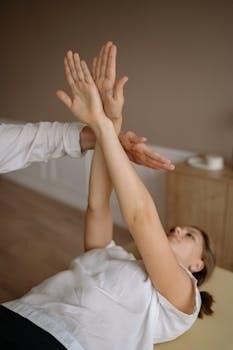Femur Fracture Physical Therapy Protocol⁚ An Overview
This protocol serves as a guideline for post-operative rehabilitation following femur fractures, aiming to restore function predictably. It incorporates interventions targeting weight-bearing, knee effusion, quadriceps control, and hip abduction strength. It is an evaluation-based approach designed to facilitate recovery after surgery.
Understanding Femur Fractures

A femur fracture signifies a break in the thigh bone, the body’s largest and strongest bone, connecting the hip and knee. Due to the femur’s strength, significant force is typically required to cause a fracture. These fractures are often severe injuries needing comprehensive rehabilitation. Proximal femur fractures in the elderly are a serious public health concern, frequently requiring surgical intervention followed by physical therapy.
Rehabilitation is often a slow, cautious process, potentially involving casts or braces for about eight weeks post-surgery. Early rehabilitation is crucial, considering that over 50% of leg muscle strength can be lost in the fractured leg within the initial week after surgery. An evaluation-based rehabilitation protocol can facilitate predictable function restoration and should be considered standard care.
Physical therapy plays a vital role in recovery, ensuring safe crutch use and gradual weight-bearing progression. The goal is to minimize stiffness, reduce swelling, and protect the healing bone, carefully advancing through rehabilitation phases based on individual progress and pain management.
Causes and Types of Femur Fractures
Femur fractures, breaks in the thigh bone, typically result from high-impact trauma due to the bone’s inherent strength. Common causes include motor vehicle accidents, falls from significant heights, and direct blows to the thigh. In elderly individuals with weakened bones due to conditions like osteoporosis, even minor falls can lead to femur fractures, particularly near the hip joint, often termed “hip fractures”.
Fractures can occur along different segments of the femur, including the femoral head, neck, shaft, and distal end. Shaft fractures, affecting the middle portion of the femur, necessitate substantial force. Proximal femur fractures, near the hip, are prevalent in older adults. The type of fracture, such as transverse, oblique, spiral, or comminuted (multiple fragments), influences treatment strategies and rehabilitation protocols.
Understanding the cause and specific type of fracture is crucial for guiding surgical intervention and subsequent physical therapy. Rehabilitation programs are tailored to address the fracture’s location, severity, and the patient’s overall health, ensuring a focused approach towards restoring function and mobility.

Initial Post-Operative Phase (Weeks 0-2)
The initial phase focuses on managing pain and edema while initiating early range of motion. Protecting the fixation site and preventing stiffness are key goals during these first two weeks post-surgery, laying the foundation for further rehabilitation.
Goals⁚ Pain and Edema Control, Early ROM
In the immediate post-operative period (weeks 0-2) following a femur fracture, the primary goals are centered around managing pain and edema, as well as initiating early range of motion (ROM) exercises. Effective pain management is crucial for patient comfort and participation in rehabilitation. Strategies may include medication, ice application, and elevation of the affected leg;
Edema control is equally important to minimize swelling and promote healing. Compression bandages and gentle massage, in addition to elevation, can aid in reducing fluid accumulation. Early ROM exercises, such as ankle pumps and gentle knee flexion/extension within a pain-free range, are introduced to prevent stiffness and promote circulation.
The focus is on achieving pain and edema control to create an optimal environment for tissue healing and to allow for a gradual increase in ROM. These initial steps are vital in setting the stage for subsequent strengthening and functional exercises, ensuring a smoother progression through the rehabilitation process.
Weight-Bearing Status and Assistive Devices
During the initial post-operative phase following a femur fracture (weeks 0-2), weight-bearing status is carefully managed to protect the healing bone. Weight-bearing restrictions are typically prescribed by the surgeon and can range from non-weight-bearing (NWB) to partial weight-bearing (PWB) or weight-bearing as tolerated (WBAT).
Assistive devices, such as crutches or a walker, are essential for maintaining balance and mobility while adhering to weight-bearing restrictions. Proper instruction on the use of these devices is crucial to ensure patient safety and prevent further injury. Physical therapists play a key role in teaching patients how to ambulate with the appropriate device and weight-bearing limitations.
The choice of assistive device and the progression of weight-bearing status depend on factors such as fracture stability, bone healing, and individual patient progress. Regular monitoring and adjustments are necessary to optimize healing and facilitate a safe return to functional activities. Early use of a walker can improve recovery.
Exercises⁚ Ankle Pumps, Quad Sets
In the immediate post-operative phase (weeks 0-2) following a femur fracture, exercises focus on initiating muscle activation and promoting circulation without stressing the healing bone. Ankle pumps and quad sets are two fundamental exercises performed during this period to achieve these goals.
Ankle pumps involve repeatedly flexing and extending the ankle, which helps to improve blood flow in the lower leg and prevent blood clots. This simple exercise can be performed frequently throughout the day, even while lying in bed. The motion also stimulates calf muscle activation, which assists with venous return.
Quad sets involve contracting the quadriceps muscles (front of the thigh) while keeping the leg straight. The patient tightens the thigh muscles, holds the contraction for a few seconds, and then relaxes. This isometric exercise helps to maintain quadriceps muscle tone and prevent muscle atrophy. Quad sets can be performed several times a day to maintain muscle activation and strength.

Intermediate Rehabilitation Phase (Weeks 2-8)
This phase focuses on progressive weight-bearing and range of motion. Strengthening exercises are introduced, including hip abduction and hamstring curls. Gait training and balance exercises are also emphasized to improve mobility and stability.
Progression Criteria⁚ Weight-Bearing and ROM
Advancement to the intermediate rehabilitation phase hinges on meeting specific criteria related to weight-bearing status and range of motion (ROM). Initially, partial weight-bearing is often prescribed, gradually increasing as tolerated. Progression to full weight-bearing requires minimal pain during weight-bearing activities, good quadriceps control, and the ability to maintain balance. The absence of increased knee effusion is also crucial.
ROM goals typically involve achieving near-full knee extension and at least 90 degrees of knee flexion. Hip ROM should also be improving, allowing for functional activities like ambulation. Pain levels should be well-managed and not exacerbated by ROM exercises. Clinical assessment, including observation of gait and functional movements, is essential in determining readiness for progression. Consistent adherence to the prescribed exercise program and avoidance of compensatory movement patterns are also important factors. Meeting these criteria ensures that the patient is prepared for the increased demands of the intermediate phase, minimizing the risk of complications and promoting optimal recovery. Remember individual progress varies.
Strengthening Exercises⁚ Hip Abduction, Hamstring Curls
During the intermediate rehabilitation phase, strengthening exercises become a focal point, with hip abduction and hamstring curls playing vital roles. Hip abduction exercises target the gluteus medius, crucial for pelvic stability and gait mechanics. These can begin with isometric contractions, progressing to resisted exercises using bands or weights. Proper form is essential to avoid compensatory movements and maximize muscle activation.
Hamstring curls strengthen the posterior thigh muscles, contributing to knee flexion and stability. These exercises often start in a prone position, using resistance bands or weight machines. Controlled movements and a full range of motion are encouraged to optimize muscle strength and flexibility. Pain levels should be monitored throughout, and exercise intensity adjusted accordingly. As strength improves, the resistance can be gradually increased; These exercises are designed to rebuild muscle strength, improve joint stability, and prepare the leg for more demanding activities. Consistency and adherence to the prescribed program are crucial for achieving desired outcomes.
Gait Training and Balance Exercises
Gait training and balance exercises are integral during the intermediate rehabilitation phase, focusing on restoring normal walking patterns and stability after a femur fracture; Gait training begins with assisted walking, using crutches or a walker, gradually progressing towards independent ambulation. Emphasis is placed on proper posture, stride length, and weight-bearing symmetry. Visual cues, such as mirrors, can aid in correcting gait deviations. As weight-bearing tolerance increases, assistive devices are weaned off, and the focus shifts to improving walking speed and endurance.
Balance exercises aim to enhance proprioception and stability, crucial for preventing falls and ensuring safe mobility. These exercises start with static balance activities, such as standing with feet together, progressing to dynamic exercises like tandem stance and single-leg balance. Perturbations and external challenges can be introduced to further challenge balance. Consistent practice and gradual progression are essential for regaining confidence and independence in walking and other functional activities. These exercises help to retrain the body’s balance mechanisms and promote a smooth, coordinated gait.

Advanced Rehabilitation Phase (Weeks 8+)
This phase focuses on returning to full function and activity. Progression depends on meeting specific criteria related to strength, range of motion, and pain levels. Functional exercises and sports-specific training are introduced to prepare for a complete return.
Criteria for Progression to Advanced Exercises
Before advancing to exercises, several key criteria must be met to ensure patient safety and optimal recovery. The individual should demonstrate adequate quadriceps control, minimizing any lag during straight leg raises. Full weight-bearing on the injured leg without pain or the use of assistive devices for ambulation is crucial. Achieving near-full range of motion in the hip and knee, comparable to the uninjured leg, is also essential.
Furthermore, strength testing should reveal at least 80% of the contralateral leg’s strength in key muscle groups, including hip abductors, extensors, and knee flexors. Absence of significant joint effusion or pain during or after exercise is necessary. The patient must also exhibit proper movement patterns without compensatory mechanisms.
A physician’s clearance, based on radiographic evidence of adequate bone healing, is often required. Finally, the individual must demonstrate understanding of proper exercise technique and precautions to prevent re-injury. Meeting these criteria ensures a safe and effective progression.
Functional Exercises⁚ Squats, Lunges
Once the criteria for progression are met, functional exercises like squats and lunges can be introduced. These exercises help in restoring strength, balance, and coordination required for daily activities. Squats should begin with partial range of motion, gradually increasing depth as tolerated, focusing on maintaining proper form and avoiding knee valgus. Lunges can start with stationary lunges, progressing to forward and lateral lunges to challenge stability.
Emphasis should be placed on controlled movements and engaging core muscles for stability. Monitor for any pain or compensatory movements, adjusting the exercise intensity as needed. These exercises help improve lower extremity strength, proprioception, and functional capacity. Start with bodyweight and gradually add resistance as tolerated, closely monitoring the patient’s response.
Progression should be based on the patient’s ability to maintain proper form and control. Functional exercises can help patients return to their pre-injury activity levels.
Return to Activity and Sports-Specific Training
The final stage involves a gradual return to pre-injury activities, including sports-specific training. Criteria for advancement include adequate strength, range of motion, and functional capacity. This phase focuses on restoring power, agility, and endurance necessary for the patient’s desired activities. Sports-specific drills should be introduced progressively, starting with controlled movements and gradually increasing intensity and complexity.
Monitoring for any signs of pain, swelling, or instability is crucial during this phase. The patient should be educated on proper warm-up techniques, biomechanics, and injury prevention strategies. This phase prepares the patient for a safe and successful return to their desired level of activity, ensuring they can participate without increased risk of re-injury.
Emphasis is placed on building confidence and optimizing performance. A tailored program ensures a safe and effective transition back to sports.
